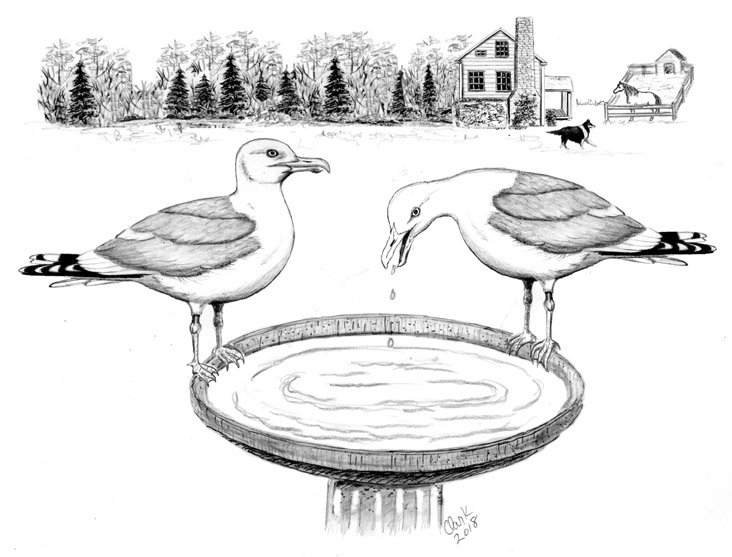
Dear Bird Folks,
When we are walking on West Dennis Beach, looking for Snowy Owls, we also like to watch the gulls. We find them to be interesting and more attractive than most people realize. Recently, many of them seem to be traveling in pairs. I assume this is all related to the upcoming breeding season. Right?
– Fred, Dennis Port, MA.
Good for you, Fred,
Whenever a Snowy Owl decides to spend the winter on one of our beaches, people step all over themselves trying to get a look at it. While I don’t blame anyone for wanting to see a beautiful owl, I can’t help wondering why many of these same people have never stopped to appreciate our more common birds such as gulls, crows and yes, jays. Don’t worry; I won’t once again mention the lack of appreciation for our dazzling Blue Jays. Wait! I think I just did. (Good for me.)
Serious birders routinely spot ten different gull species on Cape Cod, while the rest of us might only notice four species, if that. Great Black-backed, Herring and Ring-billed Gulls are common throughout the year; in the summer we are also visited by heaps of Laughing Gulls, a bird with one of the best names ever. It’s easy to understand why some folks aren’t overly impressed with gulls. Remember the old dump days? Even I found it hard to enjoy birds while they were ripping into garbage bags filled with eggshells, coffee grounds and spoiled spaghetti. In addition, for the first few years of their lives gulls simply aren’t very attractive. They are mostly mottled brown and basically look like giant sparrows…covered in coffee grounds. But eventually, but age four or five, Herring Gulls molt into their adult breeding plumage. This is when they turn into well-marked, majestic birds…regardless of what the general public thinks.
I know you didn’t ask, but I even have my own Herring Gull story. Gulls, which would rather drink fresh water when they can, routinely come to my mother-in-law’s birdbath. Some people may be less than thrilled at the sight of such big birds in their birdbath (they might “scare the cardinals”), but she loves them. She says they look like “beautiful porcelain statues,” and she is right. An adult Herring Gull, in full sun, is truly a handsome creature. The head and chest are pure white, the back is stately gray and the eyes and beak are brilliant yellow, with just a spot of red lipstick for accent. And like the birds you are watching in West Dennis, the gulls coming to her birdbath are arriving and leaving in pairs. The reason for this pairing is just as you suspected, spring, the time for couples to do what couples do best.
For most of the winter, adult Herring Gulls spend their days alone or in mixed flocks. But things change when spring arrives. Now, instead of one lone gull sitting on a piling, or on a chimney or, in some cases, on a birdbath, there will be a male and a female. How can you tell the sexes apart? It’s not easy. Other than a slight size variation (the males are larger), boy Herring Gulls look just like the girls, lipstick and all. But identifying a paired couple is easy. When one gull arrives, the other one is right behind it. And when one leaves, they both leave. We are used to seeing this behavior in songbirds (doves) and ducks (mallards), but it’s a bit odd seeing such large birds clinging to each other. This clinging behavior is something I’m very familiar with. Whenever we go shopping, my wife won’t let me out of her sight…but it’s not what you think. She knows that without me she’ll have to pay for everything, and she hates that.
It’s fun to see birds form couples, but birds don’t form the same romantic attachments that humans do. It’s more of a possession thing, like putting out a blanket on the beach or setting up lawn chairs hours before the start of a Cape League baseball game. The birds are simply claiming each other and they have to stay close in order to keep other suitors or claim jumpers away.
The male’s ultimate goal is to pass on his genes and he doesn’t want some other dude moving in on his babe. But try as he might, he doesn’t always succeed. Oftentimes his old lady sneaks off when he isn’t looking and hooks up with another male. New DNA testing tells us that nestlings often have different baby daddies. (Wait until Maury Povich hears about this.)
Herring Gull couples however, are fairly faithful to each other. In fact, it is thought they seek out the same partner year after year. They are also excellent parents…and they need to be, as a crowded gull colony is a dangerous place to raise a family. Why is that? We know gulls will eat just about anything, and that includes unguarded eggs or chicks of the birds next door. Gull parents must be constantly vigilant or their kids could end up on their neighbor’s menu. (And you thought your neighbor was a jerk.)
You are totally correct, Fred, the Herring Gull pairs you are seeing on West Dennis Beach are indeed couples, couples that have likely nested together for years. It’s ironic that folks get all mushy when they learn that swans mate for life, but it doesn’t seem to move their emotional needle when gulls do it, too. Maybe some people can’t get past the fact that gulls also eat their neighbor’s children. Picky, picky, picky.